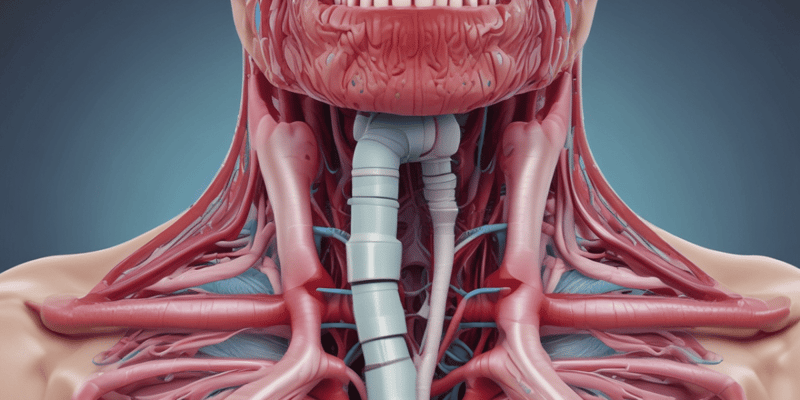Podcast
Questions and Answers
What is another name for the pharyngeal tonsils?
What is another name for the pharyngeal tonsils?
Where is the most common location for a misplaced ET tube?
Where is the most common location for a misplaced ET tube?
What is the term for the bifurcation of the trachea?
What is the term for the bifurcation of the trachea?
What lines most of the airway including the trachea?
What lines most of the airway including the trachea?
Signup and view all the answers
What is the function of the vallecula?
What is the function of the vallecula?
Signup and view all the answers
Where is the soft palate located?
Where is the soft palate located?
Signup and view all the answers
Which structure is most likely to be affected if the ET tube is pushed in too far?
Which structure is most likely to be affected if the ET tube is pushed in too far?
Signup and view all the answers
What is another term for the palatine tonsils?
What is another term for the palatine tonsils?
Signup and view all the answers
Where does the soft palate connect?
Where does the soft palate connect?
Signup and view all the answers
Which area is primarily lined by respiratory epithelium?
Which area is primarily lined by respiratory epithelium?
Signup and view all the answers
Study Notes
Nasal Cavity and Oral Cavity
- Anterior one-third of the nasal cavity is located at the front part of the nasal structure, primarily involved in respiration and olfaction.
- The oral cavity is situated posterior to the teeth and extends to the oropharynx, functioning in digestion and speech.
Airway Lining
- Pseudostratified ciliated columnar epithelium lines most of the airway, including the trachea, providing a protective barrier and facilitating mucus clearance.
Pharyngeal Anatomy
- The nasopharynx occupies the upper portion of the pharynx, situated behind the nasal cavity and above the soft palate.
- The correct name for the palatine tonsils is not adenoids or facial; palatine tonsils are distinct entities located on either side of the oropharynx.
- The pharyngeal tonsils are also known as adenoids, located in the nasopharynx.
Vallecula and ET Tube Positioning
- Vallecula refers to a groove or depression located between the base of the tongue and the epiglottis, useful in airway management during intubation.
- The most common location for a misplaced endotracheal (ET) tube is in the esophagus, which can lead to inadequate ventilation.
- If the ET tube is advanced too far, it is likely to enter the right main bronchus due to anatomical asymmetry.
Soft Palate and Trachea Bifurcation
- The soft palate is located at the back of the roof of the mouth, with its base attached to the uvula, playing a crucial role in swallowing and speech.
- The term for the bifurcation of the trachea is the carina, which marks the division into the left and right main bronchi.
Nasal Cavity and Oral Cavity
- The anterior one-third of the nasal cavity is responsible for the initial filtration, warming, and humidification of inhaled air.
- The oral cavity assists in digestion, housing teeth and salivary glands, and plays a role in speech production.
Airway Lining
- The majority of the airway, including the trachea, is lined with pseudostratified ciliated columnar epithelium, which aids in mucus clearance and protection against pathogens.
Nasopharynx
- Most of the nasopharynx is lined with respiratory epithelium, facilitating air passage and housing the adenoids.
Tonsils
- The palatine tonsils are also known as the faucial tonsils.
- The pharyngeal tonsils are commonly referred to as adenoids, located in the nasopharynx.
Vallecula
- Vallecula refers to the space situated between the glossoepiglottic folds at the back of the oropharynx, significant in airway management and intubation.
Endotracheal (ET) Tube Misplacement
- A common site for misplacement of the ET tube is in the esophagus rather than the trachea, leading to potential respiratory complications.
- If the ET tube is advanced too far, it is likely to enter the bronchi, particularly the right main bronchus, due to its anatomical orientation.
Soft Palate and Uvula
- The soft palate is located at the back of the mouth, connecting to the hard palate, and is essential for swallowing and speech.
- The base of the uvula is connected to the soft palate, serving as a partition during swallowing to prevent food from entering the nasopharynx.
Tracheal Bifurcation
- The bifurcation of the trachea is referred to as the carina, marking the point where the trachea splits into the left and right main bronchi.
Studying That Suits You
Use AI to generate personalized quizzes and flashcards to suit your learning preferences.
Description
This quiz tests your knowledge on the anatomy of the respiratory system, including the nasal cavity, oral cavity, and pharyngeal structures. Answer questions about the locations and functions of various parts of the airway. Perfect for medical students or anyone interested in human anatomy.




